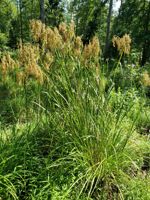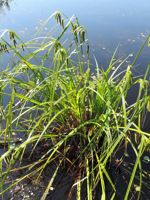Mon-Fri 9am - 5pm Mountain time
Cyperus-like Sedge vs Woolgrass
Scirpus cyperinus
Carex pseudocyperus
CUSTOM GROW
CUSTOM GROW
Woolgrass is a native perennial sedge that forms dense clumps in wetlands, ditches, and along shorelines. Its ability to thrive in saturated soils and shallow water, combined with its spreading growth habit, makes it especially valuable for waterside & riparian plantings, erosion control, ecological restoration, and naturalization projects.
The distinctive spikelets are covered in brown woolly bristles, which is where it gets the name Woolgrass. It produces seeds that are eaten by waterfowl and small mammals, while its dense stems offer cover and nesting habitat. It grows most actively in spring and fall, slowing or going dormant in the summer heat.
Cyperus-like Sedge is a native perennial sedge found in wetlands, marshes, swamps, and along shorelines. Classified as an obligate wetland species, it grows in dense clumps that thrive in saturated soils, helping stabilize wet ground and protect shorelines. These colonies also provide cover for wildlife, while the seeds may be eaten by waterfowl and other birds. It is well-suited to wetland restoration, waterside and riparian zone plantings, and naturalization projects.
Its ornamental appeal comes from the contrast between the upright male floral spikes at the top of the stems and the long, drooping female floral spikes that hang below. These seed spikes resemble those of Cyperus species, giving the plant its common name and making it an attractive addition to naturalized plantings.

